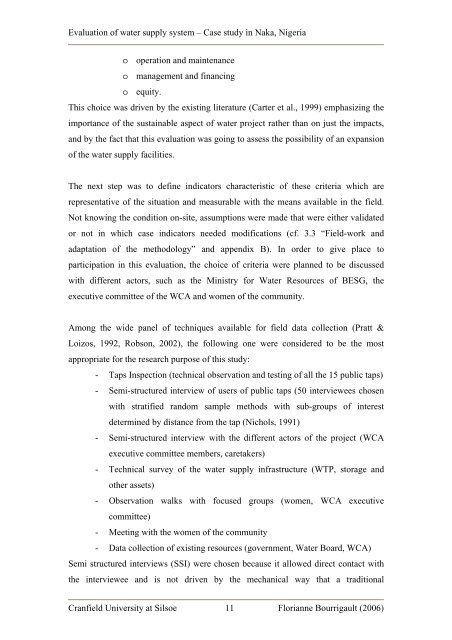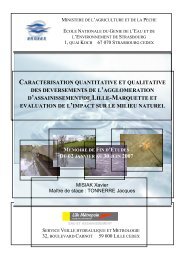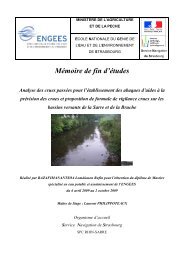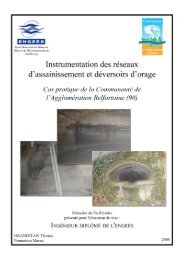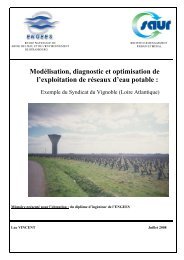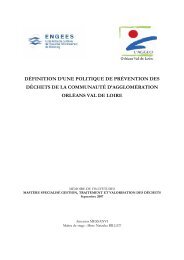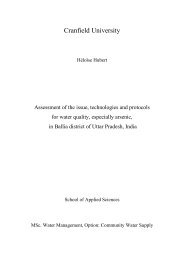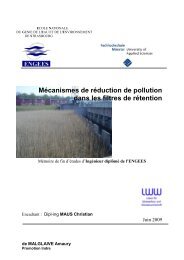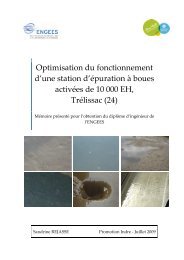Evaluation of water supply system Case study in Naka ... - ENGEES
Evaluation of water supply system Case study in Naka ... - ENGEES
Evaluation of water supply system Case study in Naka ... - ENGEES
- No tags were found...
Create successful ePaper yourself
Turn your PDF publications into a flip-book with our unique Google optimized e-Paper software.
<strong>Evaluation</strong> <strong>of</strong> <strong>water</strong> <strong>supply</strong> <strong>system</strong> – <strong>Case</strong> <strong>study</strong> <strong>in</strong> <strong>Naka</strong>, Nigeriao operation and ma<strong>in</strong>tenanceo management and f<strong>in</strong>anc<strong>in</strong>go equity.This choice was driven by the exist<strong>in</strong>g literature (Carter et al., 1999) emphasiz<strong>in</strong>g theimportance <strong>of</strong> the susta<strong>in</strong>able aspect <strong>of</strong> <strong>water</strong> project rather than on just the impacts,and by the fact that this evaluation was go<strong>in</strong>g to assess the possibility <strong>of</strong> an expansion<strong>of</strong> the <strong>water</strong> <strong>supply</strong> facilities.The next step was to def<strong>in</strong>e <strong>in</strong>dicators characteristic <strong>of</strong> these criteria which arerepresentative <strong>of</strong> the situation and measurable with the means available <strong>in</strong> the field.Not know<strong>in</strong>g the condition on-site, assumptions were made that were either validatedor not <strong>in</strong> which case <strong>in</strong>dicators needed modifications (cf. 3.3 “Field-work andadaptation <strong>of</strong> the methodology” and appendix B). In order to give place toparticipation <strong>in</strong> this evaluation, the choice <strong>of</strong> criteria were planned to be discussedwith different actors, such as the M<strong>in</strong>istry for Water Resources <strong>of</strong> BESG, theexecutive committee <strong>of</strong> the WCA and women <strong>of</strong> the community.Among the wide panel <strong>of</strong> techniques available for field data collection (Pratt &Loizos, 1992, Robson, 2002), the follow<strong>in</strong>g one were considered to be the mostappropriate for the research purpose <strong>of</strong> this <strong>study</strong>:- Taps Inspection (technical observation and test<strong>in</strong>g <strong>of</strong> all the 15 public taps)- Semi-structured <strong>in</strong>terview <strong>of</strong> users <strong>of</strong> public taps (50 <strong>in</strong>terviewees chosenwith stratified random sample methods with sub-groups <strong>of</strong> <strong>in</strong>terestdeterm<strong>in</strong>ed by distance from the tap (Nichols, 1991)- Semi-structured <strong>in</strong>terview with the different actors <strong>of</strong> the project (WCAexecutive committee members, caretakers)- Technical survey <strong>of</strong> the <strong>water</strong> <strong>supply</strong> <strong>in</strong>frastructure (WTP, storage andother assets)- Observation walks with focused groups (women, WCA executivecommittee)- Meet<strong>in</strong>g with the women <strong>of</strong> the community- Data collection <strong>of</strong> exist<strong>in</strong>g resources (government, Water Board, WCA)Semi structured <strong>in</strong>terviews (SSI) were chosen because it allowed direct contact withthe <strong>in</strong>terviewee and is not driven by the mechanical way that a traditionalCranfield University at Silsoe 11 Florianne Bourrigault (2006)


